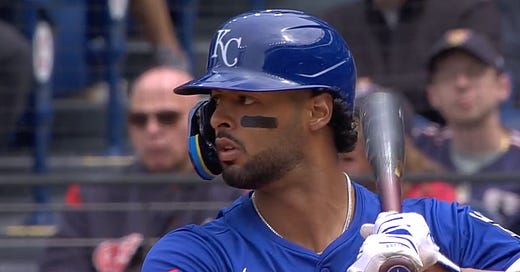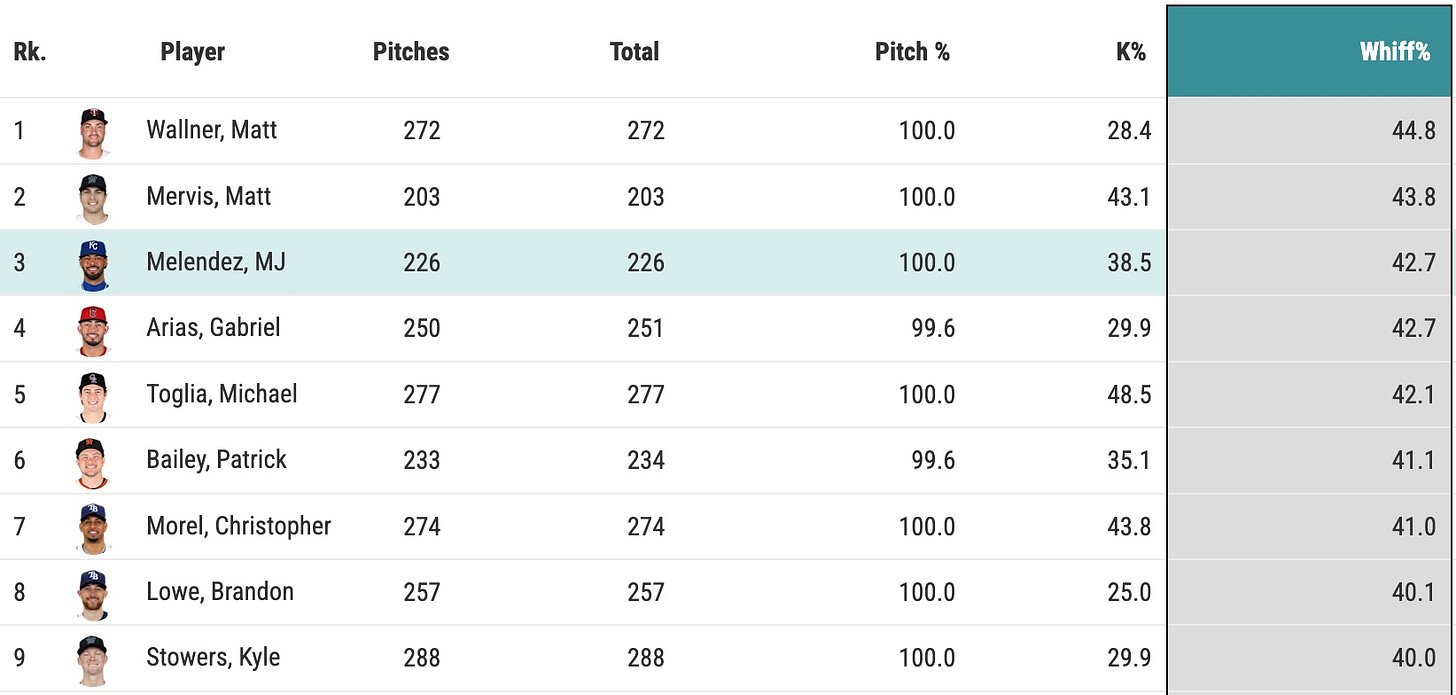This was a transaction that had to be made. On Saturday, ahead of their 3-1 loss to the Detroit Tigers, the Royals optioned outfielder MJ Melendez to Triple-A Omaha. Mark Canha completed his rehab assignment and was activated.
In a lineup full of offensively-challenged hitters (excepting Bobby Witt Jr., naturally), Melendez’s inability to produce has stood out since just about the first pitch of 2025. He has had 52 plate appearances thus far and reached base nine times. Melendez has four base hits—two singles, a double and a home run—to go along with three walks and two instances where he was hit by a pitch. Overall, he’s produced a line of .085/173/.170, which translates to a wRC+ of -2.
That’s not going to get it done.
Via Anne Rogers, here’s JJ Picollo on Melendez:
“He’s very talented. That’s the thing,” Picollo said. “He’s got tools that are hard to find. He’s got well-above-average power. He’s turned into a very good defender in left field. He throws very well. He’s an above-average runner. When a player has tools like that, you want to stick with him. Because you know he can impact the game in various ways.
“That’s why our patience was a little bit more long-lasting with MJ, just because we believe those tools are going to turn into skill. And we still believe that they will. Just the timetable may be a little bit different.”
I don’t disagree with anything Picollo said. Melendez has power. He’s worked hard to become a solid defender in left field. The arm has always been a weapon. These are all things Melendez can do on the baseball field. What Picollo didn’t say, though, is that Melendez, as a hitter, has regressed in each of his two previous seasons. This season wasn’t so much a regression as it was an absolute cratering.
There are a couple of things to point out about Melendez and his start to the season. As a jumping-off point, his .115 average on batted balls in play is obscenely low. The temptation would be to point to bad luck. That would be misguided.
The type of contact Melendez has been making this year has generally been subpar. Of the balls he’s put in the air, a whopping 18.5 percent have been categorized as pop-ups. Further, Baseball Savant characterizes 44.4 percent of all batted balls from Melendez as being hit “under.” (There have only been 27 batted ball events this year, so the usual small sample caveats apply.)
While Melendez’s metrics, like his Barrel% and Average Exit Velocity, are all around the league average, his average launch angle has shot up to 23.6 degrees. That’s an increase of nine degrees from where Melendez finished last season.
That illustration above really cuts to the issues with the contact Melendez has been making. Of the 27 balls he’s put in play, 11 have had a launch angle of 32 degrees or greater. Balls hit like that are going for outs, generally no matter how hard they’re hit. (Mainly because it’s difficult to get quality exit velocity when you’re hitting the ball at that kind of an angle.) At Kauffman Stadium, they’re definitely going for outs.
Forget about Melendez’s contact for a moment. Perhaps more alarming is the fact that he’s not making a lot of contact at all. As in, less contact than usual.
Melendez’s contact rate on swings in the zone is 66.2 percent this year, a drop of about 10 percentage points from his career rate. The average major league hitter makes contact on about 80 percent of the swings he takes on pitches in the zone.
Also, when Melendez does swing, he’s missing 42.7 percent of the time. He has always been a guy who will swing and miss more than the average major leaguer, but that’s an insanely high percentage of whiffs. It’s no wonder his strikeout rate has shot up to 38.5 percent this year.
These are the players who have seen at least 250 pitches this season with a whiff rate of 40 percent or higher.
What I found most interesting when looking at the data for Melendez at Baseball Savant, is that his overall swing rate on pitches in the zone is really quite low at just 62.5 percent. Not only is he swinging and missing at more than his share of pitches, he’s also watching a lot of strikes go by. And then his chase rate is at 31.1 percent, which is currently a career-high. That makes me wonder if Melendez is seeing the ball well. I suppose it could be an overall lack of confidence, a reluctance to pull the trigger.
What I do know is this is the profile of a player who is in the wilderness when he’s in the batter’s box.
So we have a hitter who is swinging infrequently at strikes, missing almost half the time he does swing, and then making miserable contact when the bat actually meets the baseball.
For their part, both Picollo and manager Matt Quatraro said what you would expect about Melendez. The team still believes in his talent, and this is an opportunity for a reset. More from Rogers:
“As I shared with [Melendez], there are very few players in this world who don’t get optioned at some point,” Picollo said. “It’s certainly not the end of his career. We’d like to think it’s just the start of a new beginning. Take advantage of the opportunity to go out and play in Triple-A, play well and get back here. Here, it’s about performance. You’ve got to be able to perform.”
It’s about performance. That’s now the question that surrounds Melendez: Can he perform at a level to force his way back to Kansas City? And if he returns, will he find a level of performance that will keep him on this roster?
It’s never easy to give up on a player, but I am skeptical that Melendez will hit enough to be a serviceable platoon player, let alone an everyday regular. His offensive production has always trended below average and, as noted earlier, declined in each of the last two seasons. His margin for error was extremely slim, and he tumbled into the abyss. I hope I’m wrong, and it’s just recency bias on my part, but I’m just not sure he makes it back.
After a winter where the Royals weren’t able to find suitable upgrades, this entire season was going to be about auditioning guys for spots in the outfield. They need to operate from here on out as if Melendez is no longer an option.
Saturday’s loss was another dreadful offensive performance. The Royals lone run came on a Freddy Fermin solo home run. The Tigers got their three from the bat of Spencer Torkelson who jacked a three-run bomb of Seth Lugo in the fifth. Fermin’s home run aside, the only other time a Royal touched third base came with two outs in the ninth inning. That was a moment when the actually had the tying run on base. Kyle Isbel—who is now 0-12 in the series—skied a popup to third for the final out.
Maybe Torkelson can be something of a role model for Melendez. Although Torkelson had extreme prospect pedigree, but he was a guy who underperformed his first three seasons in the majors to the point he lost his role on the Tigers prior to the 2025 season. He’s forced their hand however, and has been a force in their lineup in the early going. It can click, and a productive Torkelson makes the Detroit lineup much more formidable.
The last time this team scored more than three runs in an inning remains back in the first frame of their April 6 game against the Orioles. That was two weeks ago and covers a span of 125 innings. I didn’t think that was possible.
The Royals offense is now scoring just 2.86 runs per game, dead last in the majors. They are the only team scoring fewer than three runs a game on average.
The Royals are now 1-8 on the road trip.











But otherwise, Mrs. Lincoln, did you enjoy the play?
I wish MJ well, but I don’t think he’ll play for the Royals again. If only they had traded him after his big minor league season.